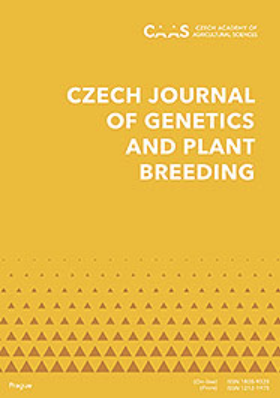植物棉登录号PI408798花瓣斑点表型的遗传特征
IF 1.8
4区 农林科学
Q3 AGRONOMY
引用次数: 4
摘要
花瓣斑点在开花植物中很常见,在吸引传粉昆虫方面起着重要作用。具有大的红色花瓣斑点的棉花基因型在美国农业部国家植物种质系统树木棉(L.)的收集中很常见。一个登录号PI408798显示出一种独特的淡红色花瓣斑点表型。为了对这一特性进行遗传表征,通过将PI 408798与没有色素花瓣斑点的G.arboreum登录号PI 529714杂交,开发了一个由226株植物组成的F2群体。从种群中,161株植物显示出微弱的红色花瓣斑点;而65株植物缺乏色素花瓣斑点。这些数据支持了花瓣斑点存在的单一显性基因模型。保藏号PI408798将提供一种重要的遗传资源来表征参与控制花色素沉着途径的基因。本文章由计算机程序翻译,如有差异,请以英文原文为准。
Genetic characterisation of the petal spot phenotype for Gossypium arboreum accession PI 408798
The occurrence of floral petal spots is common among flowering plants and plays a major role in attracting pollinators. Cotton genotypes having large red petal spots are frequent in the United States Department of Agriculture, National Plant Germplasm System Gossypium arboreum (L.) collection. One accession, PI 408798, showed a unique faint red petal spot phenotype. To genetically characterise this trait, a F2 population of 226 plants was developed by crossing PI 408798 with G. arboreum accession PI 529714 that lacked pigmented petal spots. From the population, 161 plants showed the presence of faint red petal spots; whereas, 65 plants lacked pigmented petal spots. These data supported the single dominant gene model for the presence of floral petal spots. Accession PI 408798 will provide an important genetic resource to characterise the genes involved in the pathway controlling floral pigmentation.
求助全文
通过发布文献求助,成功后即可免费获取论文全文。
去求助
来源期刊

Czech Journal of Genetics and Plant Breeding
Agricultural and Biological Sciences-Plant Science
CiteScore
2.20
自引率
0.00%
发文量
25
审稿时长
>12 weeks
期刊介绍:
Original scientific papers, critical reviews articles and short communications from the field of theoretical and applied plant genetics, plant biotechnology and plant breeding. Papers are published in English.
 求助内容:
求助内容: 应助结果提醒方式:
应助结果提醒方式:


